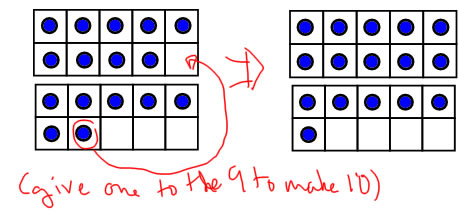
1. Explain 2 ways to use doubles to help you figure out 7+8
2. Explain 3 ways to use doubles to help you figure out 9+7
3. For each of these math fact problems, tell whether it is
a. 5+7 you can solve this by a use doubles strategy (doubles+2, doubles -2 or sandwich doubles)
b. 8+8 this is a double
c. 9+4 this isn't closely related to a double because 9 is more than 2 more than 4
d. 6+5 you can solve this by a use doubles strategy (doubles +1 or doubles -1)
e. 8+4 this isn't closely related to a double because 8 is more than 2 more than 4. Some people get mixed up because 8 is double 4, but that doesn't really help you figure out 8+4 any more efficiently than you would otherwise.
4. Describe the facts for which a use doubles strategy is efficient
Addition facts where the addends have a difference of 1 or 2.
5. Write a word problem for introducing the use doubles to add strategy.
You should have written an addition word problem where addend numbers in your problem were different by only 1 (one number was 1 more than the other). If you wrote a PPW-WU problem, that's helpful too.
6. Describe in words how to use a Make 10 strategy to solve 9+7.
Split 7 into 1+6, and join the 1 to the 9 to make 10. The sum is now 10+6=16.
8. Illustrate using a 10-frame how to use a Make 10 strategy to solve 9+7.
9. Illustrate using an open number line how to use a Make 10 strategy to solve 9+7.
10. For what addition facts is the make 10 strategy efficient?
Addition problems where one addend is 8 or 9 and the sum is more than 10.
11. What must the addends and the sum be like in order for it to be possible to use a make 10 strategy to solve the addition fact?
Both addends must be less than 10 and the sum must be greater than 10.
12. Any addition word problem type would be appropriate (JRU, PPW-WU or CQU of the more...than type). The first addend should be 9, and the second addend should be 5, 6, 7or 8.